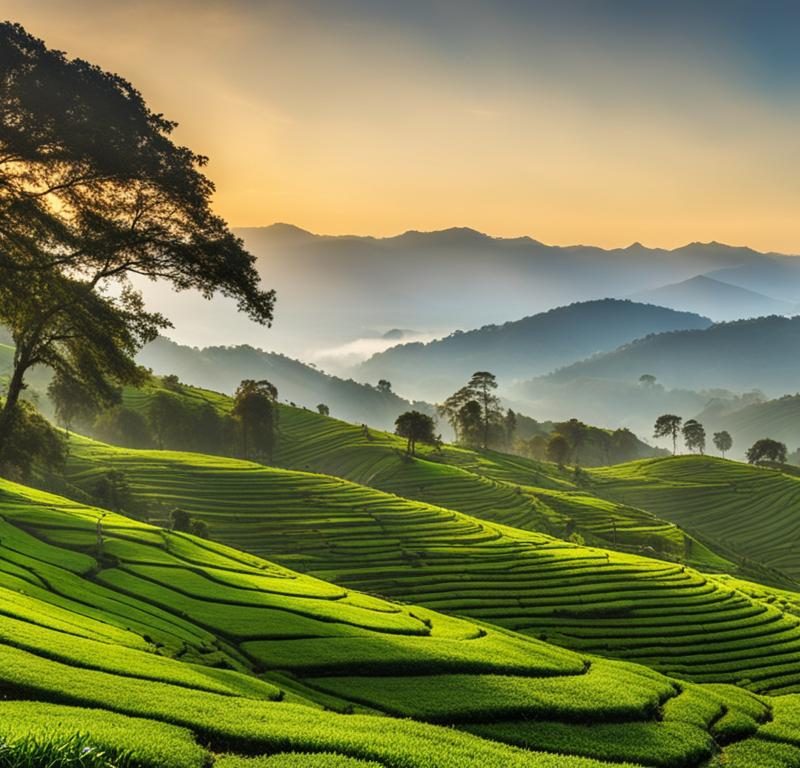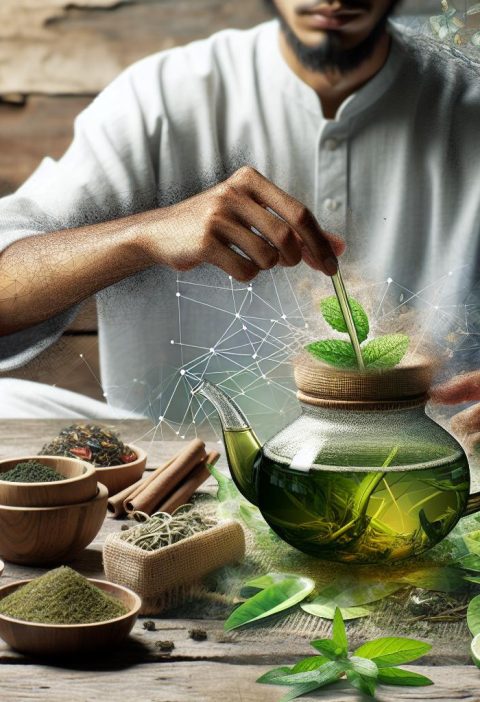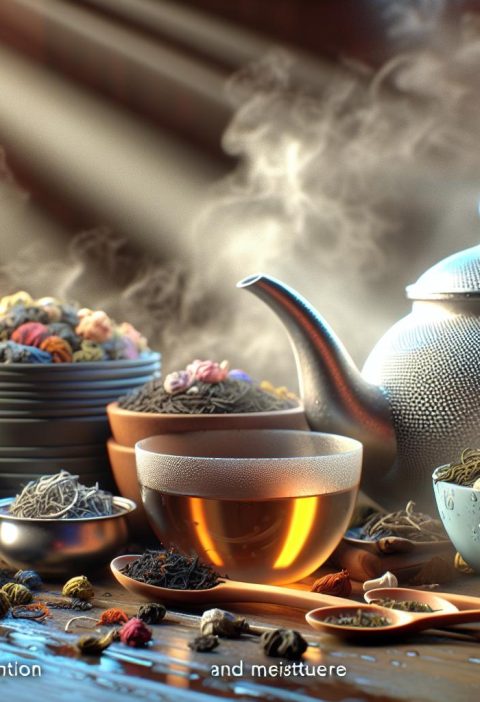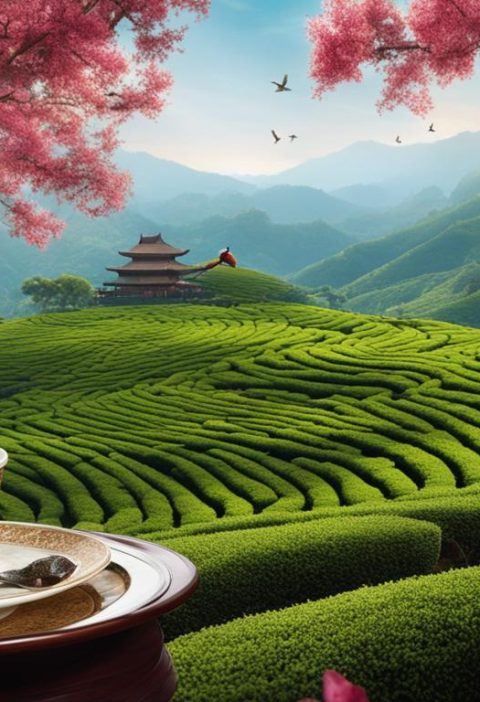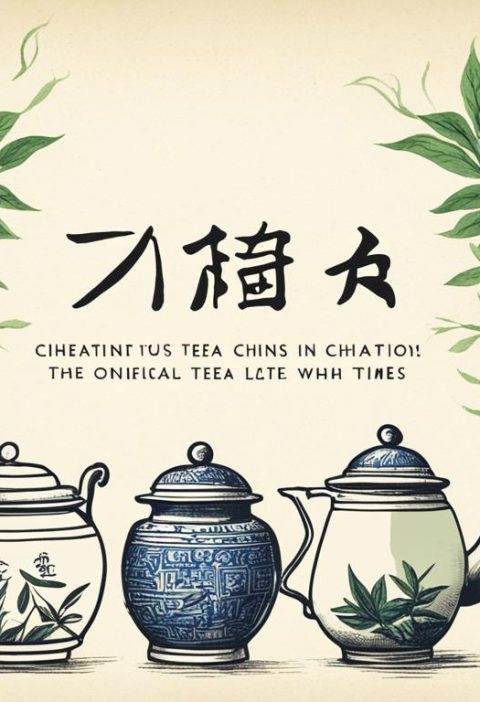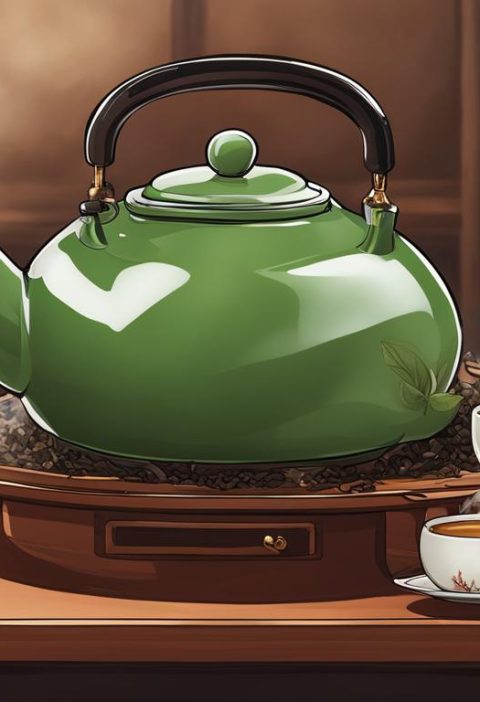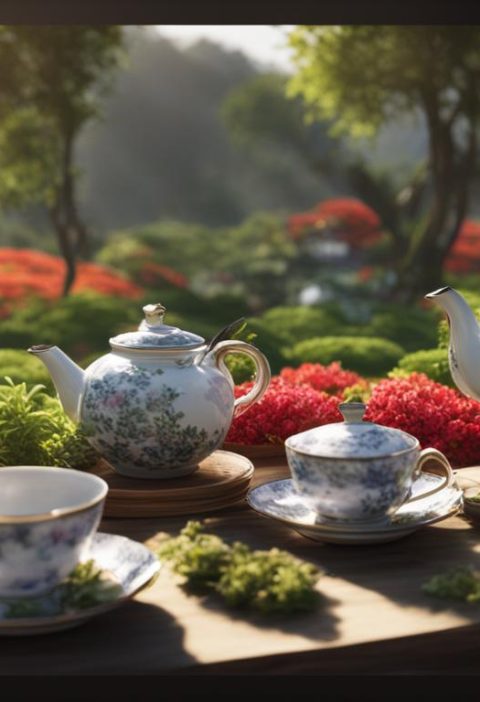Tea is a beloved beverage enjoyed worldwide, with diverse flavors and blends to suit every taste. In this article, we will delve into the world of tea regions known for their unique blends. We will explore the origins of specialty tea-producing regions and their exclusive tea origins, showcasing the wide variety of flavors and aromas available.
Key Takeaways
- Tea regions are known for producing unique blends with diverse flavors and aromas.
- Specialty tea-producing regions have exclusive tea origins that contribute to the quality and taste of the blends.
- Exploring tea regions allows tea enthusiasts to experience a wide variety of flavors and aromas.
- Each tea region has its own distinct characteristics and renowned tea estates.
- Understanding the origins of tea blends adds depth to the overall tea-drinking experience.
The History and Diversity of Black Tea Blends
Black tea is renowned for its bold and robust flavor, making it a favorite among tea enthusiasts. This section will take you on a journey through the fascinating history and diverse range of black tea blends, featuring iconic tea estates and renowned tea cultivars.
Assam
One of the most well-known black tea blends, Assam tea originates from the Assam region in India. The lush tea gardens and unique climate of Assam contribute to its distinct malty flavor, making it an excellent choice for those who prefer strong and full-bodied brews.
Darjeeling
Darjeeling, often referred to as the “Champagne of Teas,” is a black tea blend that comes from the Darjeeling region in the Indian state of West Bengal. Known for its delicate flavor and muscatel notes, Darjeeling tea is highly sought after by tea connoisseurs.
English Breakfast
English Breakfast is a classic black tea blend that is beloved for its rich and comforting taste. It is commonly enjoyed as a breakfast tea, offering a bold and robust flavor that pairs well with milk and sugar. This blend typically includes teas from various regions, creating a balanced and satisfying brew.
Earl Grey
Earl Grey is a black tea blend that is infused with bergamot oil, giving it a distinctive citrusy aroma and flavor. Named after the 19th-century British Prime Minister, Earl Grey tea offers a unique and refreshing taste that is adored by tea lovers worldwide.
Chai
Chai is a spiced black tea blend that originated in India. This aromatic blend combines black tea with a blend of spices such as cardamom, cinnamon, ginger, cloves, and pepper. The result is a warm and invigorating beverage that is often enjoyed with milk and sweetened with honey or sugar.
These black tea blends showcase the rich history and diversity of flavors within the black tea category. Whether you prefer a strong and bold cup of Assam or the delicate nuances of Darjeeling, there is a black tea blend to suit every palate.
| Black Tea Blend | Origin | Flavor Profile |
|---|---|---|
| Assam | Assam, India | Malty and full-bodied |
| Darjeeling | Darjeeling, India | Delicate with muscatel notes |
| English Breakfast | Multiple regions | Rich and robust |
| Earl Grey | Multiple regions | Citrusy and refreshing |
| Chai | India | Spicy and invigorating |
Discovering the Delicate Flavors of Green Tea Blends
Green tea blends offer delicate and refreshing flavors that are highly enjoyable. We invite you to delve into the world of green tea and explore a range of popular blends that are sure to tantalize your taste buds. From Dragonwell to Genmaicha, Gunpowder to Jasmine, Sencha to Matcha, each blend has its own unique characteristics and origins, presenting a diverse selection of flavors within the green tea category.
Types of Green Tea Blends
Let’s take a closer look at some of the most popular green tea blends:
| Green Tea Blend | Flavor Profile | Origin |
|---|---|---|
| Dragonwell | Grassy, chestnut-like | Zhejiang, China |
| Genmaicha | Nutty, toasted rice | Japan |
| Gunpowder | Earthy, smoky | Zhejiang, China |
| Jasmine | Floral, fragrant | Fujian, China |
| Sencha | Vegetal, seaweed-like | Japan |
| Matcha | Mellow, umami | Japan |
Each of these green tea blends offers a unique taste experience, ranging from the fresh grassiness of Dragonwell to the toasty notes of Genmaicha. Whether you prefer the earthy flavors of Gunpowder or the fragrant aroma of Jasmine, there is a green tea blend to suit every palate.
Green tea blends are not only delicious but also provide numerous health benefits. Rich in antioxidants and known for their potential to boost metabolism and support overall well-being, incorporating green tea into your daily routine can be a wise choice for a healthier lifestyle.
So why wait? Indulge in the delicate flavors of green tea blends and embark on a delightful journey of taste.
Exploring the Subtlety of White Tea Blends
White tea blends are renowned for their delicate flavor, natural sweetness, and light floral notes. These premium tea blends offer a unique and exquisite experience, crafted with care and precision. Let us delve into the world of white tea, exploring some of the most sought-after blends.
White Peony
White Peony is a highly regarded white tea blend, known for its beautiful appearance and subtle flavor profile. The tea leaves used in White Peony are carefully plucked and allowed to wither naturally. This gentle processing method preserves the delicate flavors and floral aroma, resulting in a truly exceptional tea.
Silver Needle
Silver Needle, also known as Bai Hao Yinzhen, is one of the most prized white tea blends in the world. It is made exclusively from tender, unopened tea buds, which are meticulously handpicked during the early spring harvest. The long, silver-colored buds give this blend its name. Silver Needle offers a delicate yet complex flavor profile, with hints of melon, honey, and a lingering sweetness.
White Mango
For those seeking a touch of tropical sweetness, White Mango is the perfect choice. This blend combines the delicate flavors of white tea with the refreshing taste of ripe mango. The result is a harmonious infusion that invigorates the senses and transports you to a sunny paradise with every sip.
These exceptional white tea blends are the result of premium tea leaves sourced from exclusive tea origins. The commitment to quality and the meticulous craftsmanship behind each blend ensures an unmatched tea-drinking experience.
Whether you enjoy the subtle elegance of White Peony, the refined purity of Silver Needle, or the tropical delight of White Mango, white tea blends are a true indulgence. Experiment with different blends to discover the nuances of flavor and experience the delightful world of white tea.
The Pleasures of Herbal and Fruit Tea Blends
Herbal and fruit tea blends provide a wide array of flavors and aromas, offering a caffeine-free alternative for tea enthusiasts. At our tea emporium, we take pride in curating a selection of high-quality herbal and fruit teas that are both delicious and beneficial for your health. Let’s dive into some of our most popular blends:
Herbal Tea Blends
1. Chamomile: Known for its soothing properties, chamomile tea is a gentle herbal infusion that promotes relaxation and better sleep. It has a delicate floral flavor with hints of apple.
2. Peppermint: Refreshing and invigorating, peppermint tea is a classic choice for digestion and overall well-being. It has a cool, minty taste that leaves a tingling sensation on your palate.
3. Rooibos: Originating from South Africa, rooibos tea is a caffeine-free herbal infusion with a naturally sweet and nutty flavor. It’s packed with antioxidants and is a great option for those looking for a caffeine-free alternative.
| Herbal Tea Blends | Flavor | Health Benefits |
|---|---|---|
| Chamomile | Delicate and floral | Soothing and promotes better sleep |
| Peppermint | Cool and minty | Refreshing and aids digestion |
| Rooibos | Sweet and nutty | Packed with antioxidants |
Fruit and Spice Tea Blends
1. Ginger Turmeric: This delightful blend combines the warmth of ginger with the earthy undertones of turmeric. It’s a perfect choice for boosting immunity and supporting overall well-being.
2. Hibiscus: Vibrantly red and tangy, hibiscus tea offers a refreshing and tart flavor. It’s known for its high vitamin C content and its ability to support heart health.
Alongside these popular herbal tea blends, our selection of fruit and spice tea blends provides an explosion of flavors:
- Ginger Turmeric
- Hibiscus
These fruit and spice tea blends are perfect for those looking for a vibrant and flavorful tea experience.
Incorporating herbal and fruit tea blends into your daily routine is not only a delicious way to hydrate but also a fantastic opportunity to explore different flavors and reap the benefits of natural ingredients. Whether you prefer a soothing herbal blend or a tangy fruit infusion, we have the perfect tea to cater to your taste buds.
The Allure of Exotic Tea Origins
Exotic tea regions are a treasure trove of unique flavors and blends, enticing tea connoisseurs with their distinct characteristics. Let us embark on a journey to explore the tea origins of Yunnan China, Assam, Darjeeling, Fujian, Kenya, and Sri Lanka, and uncover the captivating attributes of each region.
Yunnan China
In the lush landscapes of Yunnan China, tea cultivation dates back centuries. This region is famous for its Pu-erh tea, known for its earthy flavor and rich aroma. Renowned tea estates in Yunnan China produce some of the finest Pu-erh teas, cherished by tea enthusiasts worldwide.
Assam and Darjeeling
Assam and Darjeeling in India are renowned for their black tea production. Assam black tea, with its robust flavor and malty undertones, captivates the palate. Darjeeling black tea, on the other hand, offers a delicate and floral taste, often referred to as the “Champagne of teas.” The iconic tea estates of Assam and Darjeeling produce teas that are a true testament to their unique terroir.
Fujian
Fujian, China, is a region that boasts a rich tea heritage. From exquisite white teas like White Peony and Silver Needle to the enchanting oolong tea varieties like Tie Guan Yin and Da Hong Pao, Fujian presents a diverse range of flavors. The tea estates here meticulously craft teas that capture the essence of this remarkable region.
Kenya
Kenya, situated in East Africa, has emerged as a prominent tea-producing region. The teas from Kenya possess a distinct character, thanks to the region’s unique geography and climate. Black teas from Kenya are favored for their briskness and full-bodied flavor, making them a popular choice for tea blends worldwide.
Sri Lanka
Sri Lanka, formerly known as Ceylon, has carved a niche for itself in the tea world. The picturesque tea plantations of Sri Lanka produce teas that are celebrated for their bright liquor and aromatic complexity. From the well-known Ceylon black teas to the delightful Ceylon green teas, Sri Lanka offers a delightful range of flavors.
The unique flavors and renowned tea estates of these exotic tea regions highlight the artistry and dedication that goes into tea cultivation and production. Each cup of tea tells a story of the land it originates from, inviting us to savor its distinctive essence.
| Exotic Tea Regions | Distinctive Characteristics |
|---|---|
| Yunnan China | Earthy flavor, rich aroma |
| Assam and Darjeeling | Robust and malty (Assam), delicate and floral (Darjeeling) |
| Fujian | Exquisite white teas, enchanting oolong teas |
| Kenya | Briskness, full-bodied flavor |
| Sri Lanka (Ceylon) | Bright liquor, aromatic complexity |
The Captivating World of Oolong Tea
Oolong tea is a renowned tea variety that offers a fascinating range of flavors and complex tasting notes. Known for its semi-oxidized leaves, oolong tea strikes a perfect balance between the richness of black tea and the freshness of green tea. In this section, we will explore the captivating world of oolong tea, highlighting the unique characteristics and origins of this beloved beverage.
The Wuyi Mountains: A Haven for Oolong Tea Connoisseurs
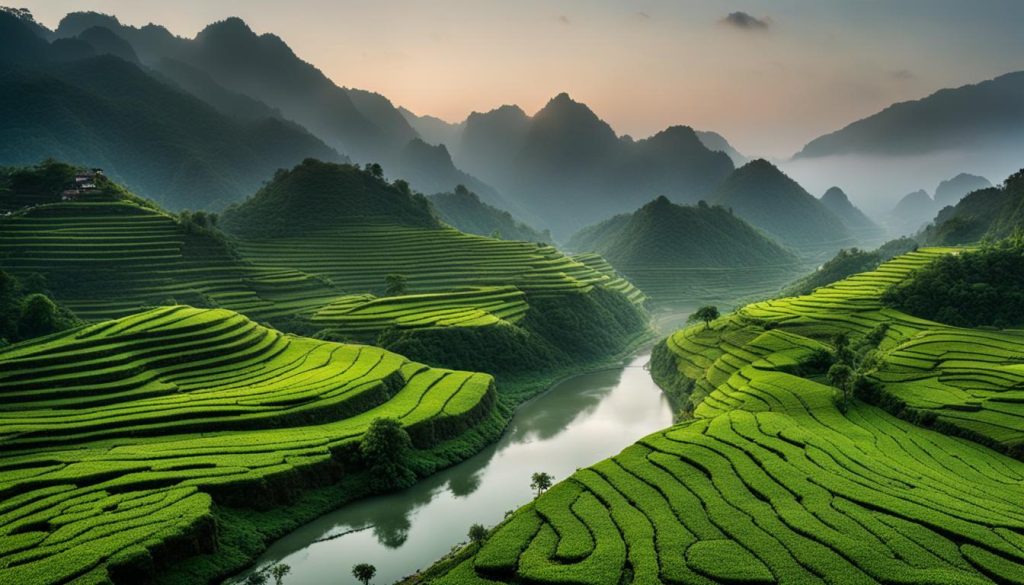
The Wuyi Mountains in Fujian province, China, are renowned for producing exceptional oolong teas. The region’s mineral-rich soil, misty climate, and unique rock formations contribute to the distinctive flavor profiles of Wuyi oolong teas. These teas are often praised for their rich floral aromas, fruity undertones, and a subtle hint of roasted nuts.
Wuyi oolong teas are meticulously handcrafted using traditional techniques that have been passed down for generations. The tea leaves are carefully picked, withered, rolled, and then roasted to perfection, resulting in teas with exceptional complexity and depth of flavor.
| Wuyi Oolong | Flavor Profile |
|---|---|
| Da Hong Pao (Big Red Robe) | Robust, toasty, and mineral-rich |
| Tie Guan Yin (Iron Goddess of Mercy) | Floral, creamy, and with a hint of sweetness |
| Rou Gui (Cinnamon) | Spicy, aromatic, and reminiscent of cinnamon |
Anxi: Home to Fragrant and Floral Oolong Teas
Anxi, also located in Fujian province, is known for producing fragrant and floral oolong teas. The pleasant climate and fertile soil of Anxi create the perfect conditions for cultivating teas with unique aromatic qualities. The most famous oolong tea from Anxi is Tie Guan Yin, renowned for its delicate orchid-like fragrance and refreshing taste.
| Anxi Oolong | Flavor Profile |
|---|---|
| Tie Guan Yin (Iron Goddess of Mercy) | Floral, orchid-like, and with a lingering sweet aftertaste |
| Huang Jin Gui (Golden Osmanthus) | Fruity, honey-like, and with a subtle osmanthus aroma |
| Mao Xie (Hairy Crab) | Grassy, vegetal, and refreshing |
Taiwan: A Haven for Exquisite Oolong Teas
Taiwan is renowned for its high-quality oolong teas, known for their exceptional flavors and aromas. The island’s mountainous terrain, misty climate, and expertise in tea cultivation contribute to the production of exquisite oolong teas. Taiwan oolong teas are characterized by their smooth and creamy texture, floral and fruity notes, and a lingering sweetness.
| Taiwan Oolong | Flavor Profile |
|---|---|
| Dong Ding (Frozen Summit) | Roasted, caramel-like, and with a smooth finish |
| Alishan | Light, floral, and with a refreshing aroma |
| Lishan | Fruity, honey-like, and with a lingering sweetness |
Each region offers a unique expression of oolong tea, showcasing the skill and artistry of the tea producers. Whether you prefer the robust flavors of Wuyi oolongs, the fragrant charms of Anxi teas, or the exquisite taste of Taiwanese oolongs, exploring the world of oolong tea is a journey of discovery and delight.
Exploring the Secrets of Pu-erh Tea
Pu-erh tea is a distinct and fermented tea variety that originates from China’s Yunnan province. With its rich history and unique production methods, pu-erh tea offers a truly exceptional tea-drinking experience.
When it comes to pu-erh tea, there are two main types: raw pu-erh and ripe pu-erh. Each type has its own characteristics and flavors that appeal to tea enthusiasts worldwide.
The Uniqueness of Raw Pu-erh
Raw pu-erh, also known as sheng pu-erh, undergoes a natural fermentation process that takes place over years or even decades. This time-honored aging process results in a tea with an earthy flavor and a vibrant, golden liquor.
Raw pu-erh is cherished for its grassy and floral notes, reminiscent of a spring meadow. Its complexity and depth of flavor make it a favorite among connoisseurs. As the tea ages, it develops a richer aroma and a mellow taste that captivate the senses.
Brewing raw pu-erh requires finesse and patience. It is recommended to use boiling water and allow the tea to steep for 1-2 minutes for the first few infusions, gradually increasing the steeping time for subsequent brews. This method ensures a full-bodied and satisfying cup of pu-erh tea.
The Indulgence of Ripe Pu-erh
Ripe pu-erh, also known as shou pu-erh, goes through an accelerated fermentation process that mimics the aging of raw pu-erh. This process results in a tea with a smooth and mellow flavor, often described as earthy and rich.
Ripe pu-erh is appreciated for its deep, dark liquor and its ability to provide a comforting and indulgent tea-drinking experience. Its flavor profile may contain hints of cocoa, wood, and sometimes even dried fruit. The complexity of ripe pu-erh makes it a delight for those seeking a well-rounded and satisfying cup of tea.
When brewing ripe pu-erh, it is recommended to use water just below boiling point and steep the tea for 2-3 minutes. These brewing parameters help extract the full richness and depth of flavors present in ripe pu-erh.
Regardless of whether you prefer the grassy and floral complexity of raw pu-erh or the smooth and indulgent flavors of ripe pu-erh, pu-erh tea is a journey worth exploring. Its unique characteristics and brewing techniques make it a captivating addition to any tea collection.
| Pu-erh Tea Varieties | Description |
|---|---|
| Raw Pu-erh | Distinct and earthy flavor with grassy and floral notes. Ages naturally, offering a mellow taste and a rich aroma. Requires precise brewing techniques for a full-bodied cup. |
| Ripe Pu-erh | Smooth and mellow flavor with an earthy and rich profile. Goes through an accelerated fermentation process, providing a satisfying and indulgent tea-drinking experience. Best brewed with water just below boiling point. |
The Vibrant World of Matcha Tea
Matcha tea, with its vibrant green color and unique preparation method, offers a one-of-a-kind experience for tea lovers. This powdered green tea has a rich and smooth flavor with a hint of natural sweetness, making it a favorite among enthusiasts. The vibrant green color is a result of the special growing and processing techniques that help retain the tea leaves’ chlorophyll content.
Matcha tea has a distinctive umami flavor, often described as savory and smooth, which sets it apart from other teas. The unique preparation method involves whisking the finely ground tea powder with hot water, creating a frothy and velvety beverage. This ceremonial preparation has its roots in Japanese tea culture and is an integral part of traditional Japanese tea ceremonies.
Origins and Cultural Significance
Matcha tea has a rich history that dates back to ancient times in Japan. It was initially introduced by Buddhist monks, who brought the tea seeds from China and cultivated them in Japanese monasteries. Over the centuries, matcha tea became popular among the noble class and eventually spread to the general population.
Japanese tea ceremonies, known as “chanoyu” or “sado,” emphasize the aesthetic and meditative aspects of preparing and serving matcha tea. These ceremonies are deeply rooted in Japanese culture and are an opportunity to appreciate the harmony, respect, and tranquility associated with tea drinking. The preparation and consumption of matcha tea in a ceremonial setting symbolize purity, mindfulness, and connection with nature.
Today, matcha tea has gained international popularity and is celebrated for its health benefits and unique flavor profile. Its vibrant green color, umami flavor, and association with Japanese tea ceremonies make it an intriguing choice for tea connoisseurs and newcomers alike.
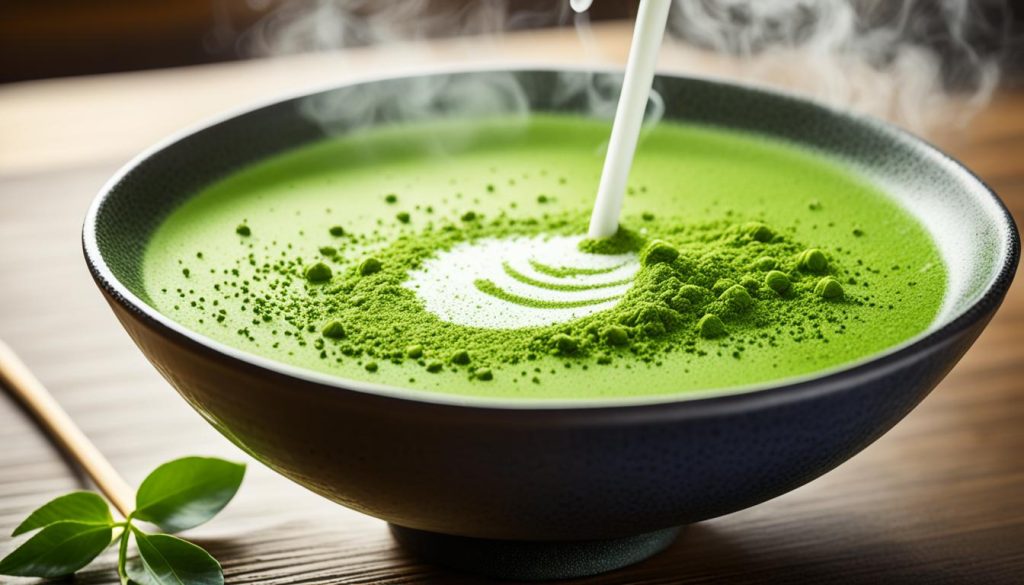
How to Enjoy Matcha Tea
To fully experience the delights of matcha tea, it is important to follow the proper preparation method. Here’s a step-by-step guide:
- Start by sifting 1-2 teaspoons of matcha tea powder into a bowl to remove any lumps.
- Add a small amount of hot (not boiling) water to the bowl and whisk the tea vigorously in a zigzag motion using a bamboo whisk (chasen) until you achieve a smooth and frothy consistency.
- Pour the remaining hot water (about 2-3 ounces) into the bowl and continue whisking until fully blended.
- Your matcha tea is now ready to be enjoyed! Sip it slowly, savoring the unique flavors and textures.
Matcha tea can be enjoyed on its own or paired with traditional Japanese sweets, which complement its flavor profile. The tea’s smooth and creamy texture makes it a versatile ingredient that can be used in various culinary creations, such as matcha lattes, smoothies, ice creams, and baked goods.
So, the next time you crave a vibrant and flavorful tea experience, immerse yourself in the world of matcha tea. Indulge in its vibrant green color, savor its umami flavor, and appreciate the unique preparation method that has captivated tea lovers for centuries.
The Allure of Tea: A Journey of Taste and Culture
Tea, the beloved beverage enjoyed by millions around the world, is more than just a drink. It is a fascinating journey of taste and culture that spans centuries and continents. From the rolling hills of Darjeeling to the serene tea gardens of Japan, tea-growing regions offer diverse flavors that captivate the senses.
Each cup of tea tells a story, reflecting the cultural significance of the region it originates from. Whether it’s the delicate and floral notes of a Green Jasmine tea or the earthy richness of a Pu-erh tea, the traditions and customs associated with tea are deeply rooted in the cultures they belong to.
The quality and taste of tea are influenced by numerous factors, including the unique terroir of tea-growing regions, the specific tea cultivars cultivated, and the meticulous processing methods employed. These elements come together to create teas of exceptional quality that satisfy even the most discerning palates.
So embark on a journey of taste and culture as you explore the enchanting world of tea. Discover the diverse flavors that each tea-growing region has to offer. Uncover the cultural significance behind each cup of tea. And savor the unparalleled quality and taste that have made tea a cherished beverage across the globe.
